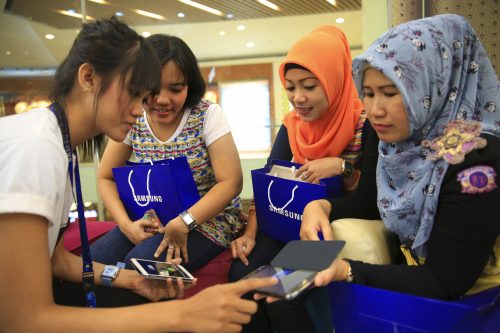Digital solutions can boost Asian women’s workplace roles

The digital economy is expanding rapidly in Asia, boosting growth and economic opportunities at a time of otherwise disappointing global productivity growth. How then does the digital economy affect opportunities for women to participate in the workforce?
Between 2000 and 2016 internet users in Asian countries increased from around 6 per cent to almost 54 per cent of the population. This was driven largely by mobile phone penetration, which increased from around 13 subscriptions per 100 people in 2000 to 129 subscriptions per 100 people in 2016.
At the same time women’s workforce participation increased across the region, with the average participation rate rising from around 45 per cent of the female population in 2000 to 46.9 per cent in 2016.
Perhaps unsurprisingly we find a significant positive association between internet use and women’s workforce participation. Indeed, our most conservative estimate suggests that growth in internet use can account for an amount equivalent to all of the increase in women’s workforce participation in Asia between 2000 and 2016.
However, this result does not necessarily imply that internet use is the cause of increased participation. Some of the increase in internet use in the region is potentially driven by greater levels of women’s workforce participation.
A more formal assessment of the association between internet use and women’s workforce participation needs variables that are strongly related to increases in internet use and unlikely to directly affect women’s participation.
For instance, states typically regulate the internet and traditional media sources in an attempt to control communication that is deemed political or otherwise anti-social — not to restrict the participation of women in the workforce.
Variables representing the absence of state control over internet access and, conversely, the presence of state control over traditional media sources, are likely to be positively related to internet use and not directly related to women’s workforce participation.
Using data representing ‘state control over internet access’ and ‘access to foreign information’ in the form of foreign newspapers and television channels as instruments, our research confirms a significant positive association between women’s workforce participation and exogenously determined internet use, at least since 2008.
Indeed, we actually find a stronger positive association between internet use and women’s workforce participation using this approach. Our results also provide indirect evidence that freedom of the internet from state interference and the free flow of information online are associated with higher levels of women’s workforce participation in Asia.
Internet use increases the pace of knowledge and technology transfer across borders and helps raise productivity. The World Bank estimates that a 10 percentage point increase in internet use is associated with a 0.77 percentage point increase in GDP growth in high-income countries, and a 1.12 percentage point increase in low and middle income countries.
Between 2000 and 2016 average internet use in Asia increased by a staggering 47.7 percentage points. The resulting increase in output and productivity, combined with changing social attitudes towards women in the workforce, should increase demand for women workers and contribute to higher women’s workforce participation.
The rapid increase in the availability and use of mobile phones in the region has reduced the costs of obtaining information and transactions, lowered the costs of money transfer and financial services, improved access to credit and helped women better coordinate their work and family lives.
Automation and skill-based technological change has also increased the demand for ‘brains’ relative to ‘brawn’, and helped women close participation and pay gaps. In developed economies, the internet increases women’s workforce participation by supporting teleworking and flexible work arrangements, and reducing the time spent on unpaid household labour.
Our findings concerning the significant positive relationship between internet use and women’s workforce participation provide a number of important insights for policymakers.
Current e‑commerce negotiations could provide the most important trade policy contribution to gender equality, relative to other negotiations underway.
For example, ambitious outcomes for the Regional Comprehensive Economic Partnership (RCEP) e‑commerce chapter and World Trade Organization negotiations on trade-related aspects of e‑commerce will be important to improve women’s economic empowerment, building on the successful negotiation of the e‑commerce chapter in the Comprehensive and Progressive Agreement for Trans-Pacific Partnership (CPTPP).
Equally important will be maintaining risk-based approaches to cybersecurity; taking a multi‑stakeholder approach to internet governance; adopting and using international standards for the digital economy; and maintaining a free and open internet. If women are to participate equally in the digital economy, policymakers need to ensure that it is a safe space for women and that human rights apply online as they do offline.
Policymakers should seek to place a gender perspective at the centre of national digital strategies, and to implement policies that improve women’s effective access to digital connectivity and skills. Women need to be able to contribute to the design and implementation of these policies through user or citizen-centred processes.
Improving the availability of gender-disaggregated ICT data can help policymakers apply a gender lens to evidence-based digital policy design and evaluation.
Finally, country-specific factors such as cultural, religious and other value systems that influence women’s participation in the workforce must be addressed. The challenge of bridging the digital divide in the region is not simply a matter of providing equal access to digital technology and skills. It is also about changing community attitudes and norms about the appropriate roles for women in society and the digital economy.
This article was written by Timothy Watson, a Sir Roland Wilson Scholar at the Crawford School of Public Policy, Michael Corliss, a research associate at the Centre for Labour Market Research at the University of Canberra, and Michelle Le ,a Master of Economics student at The Australian National University. It is based based on the authors’ research, ‘Digitalisation and women’s workforce participation in the Indo-Pacific,’ published in the Australian Journal of Labour Economics, 2018.
The article was published by the East Asia Forum and was abridged from a version that appears in the latest issue of East Asia Forum Quarterly, ‘Investing in Women’.
Michael Corliss is a Senior Analyst at Australian Government Department of Jobs and Small Business and a research associate at the Centre for Labour Market Research at the University of Canberra.










